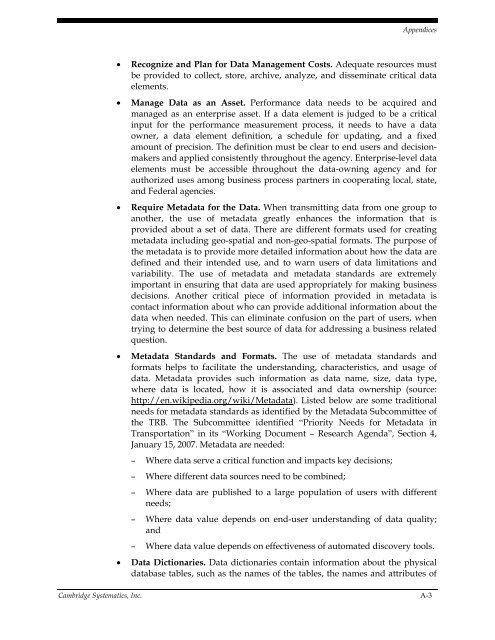CDOT Performance Data Business Plan - Cambridge Systematics
CDOT Performance Data Business Plan - Cambridge Systematics
CDOT Performance Data Business Plan - Cambridge Systematics
Create successful ePaper yourself
Turn your PDF publications into a flip-book with our unique Google optimized e-Paper software.
Appendices<br />
<br />
<br />
<br />
<br />
<br />
Recognize and <strong>Plan</strong> for <strong>Data</strong> Management Costs. Adequate resources must<br />
be provided to collect, store, archive, analyze, and disseminate critical data<br />
elements.<br />
Manage <strong>Data</strong> as an Asset. <strong>Performance</strong> data needs to be acquired and<br />
managed as an enterprise asset. If a data element is judged to be a critical<br />
input for the performance measurement process, it needs to have a data<br />
owner, a data element definition, a schedule for updating, and a fixed<br />
amount of precision. The definition must be clear to end users and decisionmakers<br />
and applied consistently throughout the agency. Enterprise-level data<br />
elements must be accessible throughout the data-owning agency and for<br />
authorized uses among business process partners in cooperating local, state,<br />
and Federal agencies.<br />
Require Metadata for the <strong>Data</strong>. When transmitting data from one group to<br />
another, the use of metadata greatly enhances the information that is<br />
provided about a set of data. There are different formats used for creating<br />
metadata including geo-spatial and non-geo-spatial formats. The purpose of<br />
the metadata is to provide more detailed information about how the data are<br />
defined and their intended use, and to warn users of data limitations and<br />
variability. The use of metadata and metadata standards are extremely<br />
important in ensuring that data are used appropriately for making business<br />
decisions. Another critical piece of information provided in metadata is<br />
contact information about who can provide additional information about the<br />
data when needed. This can eliminate confusion on the part of users, when<br />
trying to determine the best source of data for addressing a business related<br />
question.<br />
Metadata Standards and Formats. The use of metadata standards and<br />
formats helps to facilitate the understanding, characteristics, and usage of<br />
data. Metadata provides such information as data name, size, data type,<br />
where data is located, how it is associated and data ownership (source:<br />
http://en.wikipedia.org/wiki/Metadata). Listed below are some traditional<br />
needs for metadata standards as identified by the Metadata Subcommittee of<br />
the TRB. The Subcommittee identified “Priority Needs for Metadata in<br />
Transportation” in its “Working Document – Research Agenda”, Section 4,<br />
January 15, 2007. Metadata are needed:<br />
– Where data serve a critical function and impacts key decisions;<br />
– Where different data sources need to be combined;<br />
– Where data are published to a large population of users with different<br />
needs;<br />
– Where data value depends on end-user understanding of data quality;<br />
and<br />
– Where data value depends on effectiveness of automated discovery tools.<br />
<strong>Data</strong> Dictionaries. <strong>Data</strong> dictionaries contain information about the physical<br />
database tables, such as the names of the tables, the names and attributes of<br />
<strong>Cambridge</strong> <strong>Systematics</strong>, Inc. A-3

















